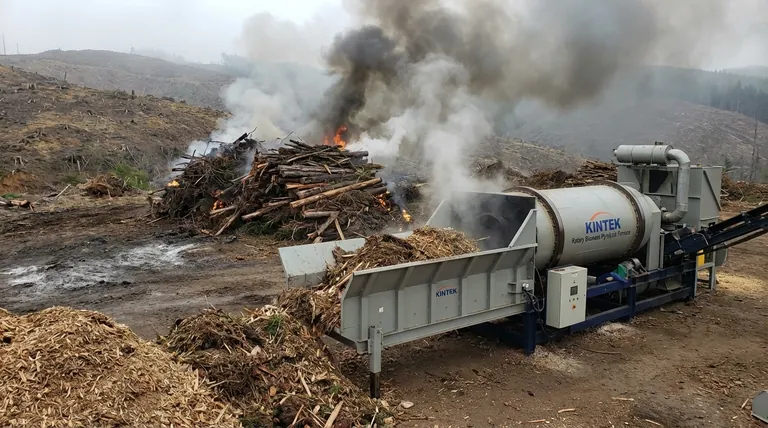Despite its reputation as a renewable resource, biomass energy carries significant environmental disadvantages. Its primary drawbacks include the potential for high carbon emissions, the risk of deforestation and habitat destruction, and significant consumption of land and water resources. The common assumption that biomass is "carbon neutral" is a dangerous oversimplification that masks its true environmental cost.
The core issue with biomass is that its environmental benefit is entirely conditional. While it can be a sustainable use of waste in small-scale applications, its use in large-scale energy production often creates environmental problems—from carbon debt to ecosystem damage—that can rival those of fossil fuels.

The Myth of Carbon Neutrality
The central argument for biomass is that it's part of the natural carbon cycle. A tree absorbs carbon, is burned for energy, and a new tree grows back to reabsorb the same carbon. In reality, this cycle is easily broken.
The Problem of "Carbon Debt"
When a tree is burned, its stored carbon is released into the atmosphere almost instantly. However, it takes a new tree decades, or even centuries, to grow and reabsorb an equivalent amount of carbon.
This time lag creates a "carbon debt." For a significant period, there is more CO2 in the atmosphere, contributing to climate change just like fossil fuels.
Emissions at the Smokestack
On a per-megawatt-hour basis, burning wood can actually release more CO2 at the smokestack than burning coal.
Beyond CO2, burning biomass also releases other harmful air pollutants, including nitrogen oxides (NOx), volatile organic compounds (VOCs), and fine particulate matter (PM2.5), which contribute to smog, acid rain, and public health issues.
The Impact on Land and Ecosystems
The source of the biomass fuel is the single most important factor determining its environmental impact. Relying on forests for fuel creates immense pressure on natural ecosystems.
The Risk of Deforestation
A rising demand for wood pellets and other biomass fuels can incentivize the clear-cutting of natural, old-growth forests—not just the use of forestry residues or waste wood.
This practice destroys vital carbon sinks, eliminating the forest's ability to absorb CO2 from the atmosphere for good.
Loss of Biodiversity
Converting diverse, natural forests into single-species tree plantations to supply biomass facilities destroys complex habitats. This practice decimates local biodiversity, impacting countless species of plants, animals, and insects that rely on the natural forest ecosystem.
Soil Degradation
Using "forest residue" like stumps, branches, and leaf litter for biomass robs the forest floor of essential organic material. This material would normally decompose, returning critical nutrients to the soil. Its removal leads to long-term soil degradation and reduces the forest's overall health and resilience.
Understanding the Trade-offs and Hidden Costs
Beyond direct emissions and forest impact, the entire biomass supply chain has hidden environmental costs that are often overlooked.
High Water Consumption
Growing dedicated energy crops or managed forests for biomass is an incredibly water-intensive process. In water-scarce regions, this can place a severe strain on local water supplies, impacting both communities and natural aquatic ecosystems.
Land Use Competition
Using vast tracts of land to grow energy crops can directly compete with land needed for food production. This competition can contribute to rising food prices and food insecurity, creating a conflict between energy needs and human needs.
Logistical and Energy Inputs
The biomass supply chain is not energy-free. Significant energy is required to harvest, process, transport, and store the raw material.
Furthermore, as the provided reference notes, storing biomass requires costly and high-maintenance facilities to prevent it from decaying. These logistical hurdles add to the overall cost and environmental footprint, diminishing the net energy gain.
Making the Right Choice for Your Goal
The viability of biomass as a "green" energy source is not a simple yes or no; it depends entirely on the scale of the project and the source of the fuel.
- If your primary focus is small-scale energy from genuine waste: Biomass can be a sustainable choice when using agricultural residues, municipal organic waste, or sawmill byproducts that would otherwise be discarded.
- If your primary focus is large-scale, industrial power generation: The environmental risks—including deforestation, carbon debt, and ecosystem damage—are substantial and often make biomass a poor substitute for genuinely low-carbon sources like solar or wind.
- If your primary focus is evaluating energy policy: It is critical to reject blanket claims of "carbon neutrality" and scrutinize the full lifecycle of the biomass source, including land-use changes and the carbon debt timeframe.
Ultimately, judging biomass requires moving beyond the simple "renewable" label to rigorously assess its true impact on our climate and ecosystems.
Summary Table:
| Key Disadvantages | Environmental Impact |
|---|---|
| Carbon Debt | Time lag in CO2 reabsorption worsens climate change. |
| Deforestation Risk | Loss of carbon sinks and biodiversity. |
| Air Pollution | Releases more CO2, NOx, and PM2.5 than coal per unit. |
| Soil Degradation | Removal of forest residues depletes soil nutrients. |
| High Water Use | Strains local water resources in scarce regions. |
| Land Competition | Conflicts with food production, raising food prices. |
Need precise, sustainable solutions for your energy or laboratory projects? At KINTEK, we specialize in providing advanced lab equipment and consumables that support accurate environmental impact analysis and sustainable research. Whether you're evaluating energy sources or developing eco-friendly technologies, our tools ensure reliable data and efficiency. Contact us today to explore how KINTEK can empower your work with cutting-edge laboratory solutions!
Visual Guide

Related Products
- Electric Rotary Kiln Small Rotary Furnace Biomass Pyrolysis Plant
- Evaporation Boat for Organic Matter
- Super Negative Oxygen Ion Generator Machine for Air Purification
- Electric Rotary Kiln Continuous Working Small Rotary Furnace Heating Pyrolysis Plant
- Graphite Vacuum Furnace Bottom Discharge Graphitization Furnace for Carbon Materials
People Also Ask
- What are the reactions involved in pyrolysis of biomass? Unlock the Chemistry for Tailored Bio-Products
- What are the components of biomass pyrolysis? A Complete Guide to the System, Products, and Process
- How is energy converted into biomass? Harnessing Nature's Solar Power for Renewable Energy
- What are the products of pyrolysis of biomass? Unlock Bio-Char, Bio-Oil, and Syngas
- Is pyrolysis viable? A Guide to Economic, Technological, and Environmental Success






